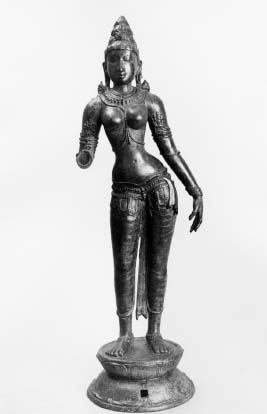HinduismSigns and Symbols |
What sort of symbols and signs will I see in a Hindu temple? |
First you will remove your shoes as a sign of respect for a holy place, and to help keep it clean, since worshippers often sit on the floor. Very near the door you will see an image or statue of the elephant-headed deity called Ganesha. One of Shiva’s two sons, Ganesha is the guardian of openings, beginnings, and travelers, and he generally bestows blessings on worshippers as they enter. Even Vaishnavite temples usually have a Ganesha at the door. Along the side walls you may see smaller shrines containing images of deities important in one or another denomination but secondary to this particular temple’s devotional focus. Straight ahead you will see the central shrine, perhaps flanked by a pair of subordinate shrines holding images of deities directly related to the one in the central shrine. For example, if the temple is primarily dedicated to a manifestation of Vishnu called Shri Venkateshvara (as are temples in Pittsburgh and St. Louis), flanking shrines might house Krishna and Radha on one side and Rama with wife Sita, brother Lakshmana, and the monkey assistant Hanuman on the other.
The subordinate shrines may have prominent spires somewhat shorter than that of the central shrine. If the temple serves a large and diverse community, other side rooms may be devoted to other deities. Vishnu’s consort, Lakshmi, goddess of wealth and success, often has her own shrine, sometimes with a shikhara, whose external elevation is slightly lower than those of the central shrine and its flanking shrines. Another room might house one large and several smaller shrines dedicated to Shiva and his “holy family.” In the main Shiva shrine you will see an abstract symbol of power and blessing called the lingayoni, the principal aniconic symbol of Shiva. Alongside, smaller shrines will display images of Parvati, Shiva’s wife, and their two sons, Ganesha and Skanda (also known as Karttikeya and Murugan). Many, if not all, images will be elaborately clothed and festooned with floral garlands. Decorative themes on the shrines might include images of guardian figures called “doorkeepers” and other protective symbols that look like small lion faces.

An eleventh century bronze of the goddess Parvati, consort and divine energy (Shakti) of Shiva, Chola period (c. 900-1200), Tanjore district, India. (The Saint Louis Art Museum.)
